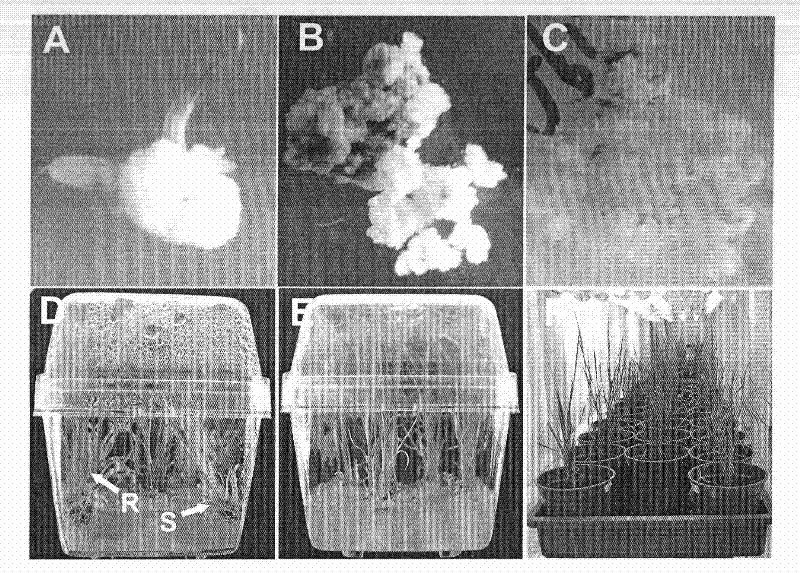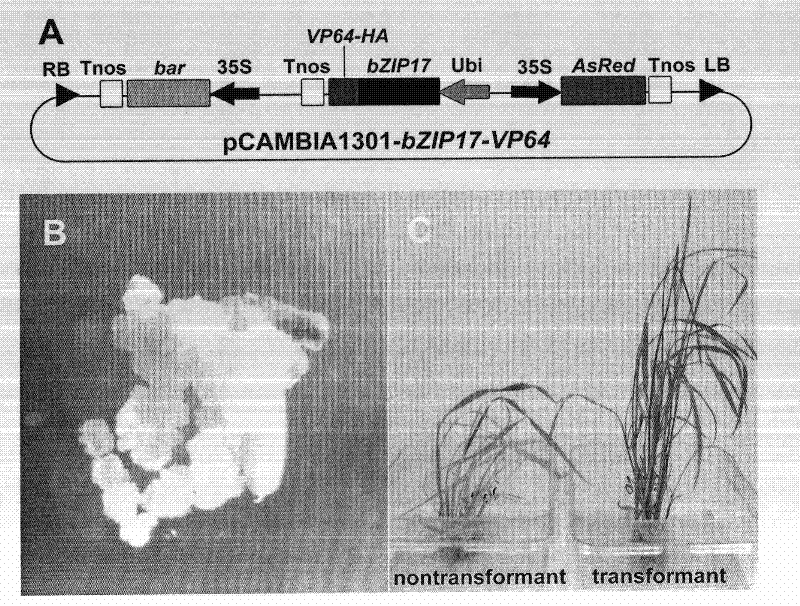Rapid and high-efficiency transgenic method for indica rice
A transgenic and genetic technology, applied in the field of transgenics, can solve the problems of increased frequency of somatic cell mutations, difficulties in phenotypic identification and biochemical analysis of transformed strains, and achieve the effects of reducing mutation frequency, shortening in vitro culture time, and short transformation cycle
- Summary
- Abstract
- Description
- Claims
- Application Information
AI Technical Summary
Problems solved by technology
Method used
Image
Examples
Embodiment 1
[0046] 1. Induction of Callus
[0047] Select the seeds of Xiangling 628S, an indica rice variety that is well-ripe, plump, and mildew-free, and use a brown rice machine to remove the inner and outer shells of the seeds. First sterilize with 70% alcohol for 2 minutes, then soak in 30% NaClO+0.1% Tween 20 solution, and put it on a shaker at 100rpm for 30 minutes. On the ultra-clean workbench, the sterilized deveined seeds were washed 5 times with sterile water, then transferred to a petri dish equipped with sterile absorbent paper to absorb the water, and then inoculated in the induction medium. The culture conditions were 32°C, continuous light (100 μmole m -2 the s -1 ). After 7 days, the callus was induced at the scutellum of the seed embryo, and then the whole seed was used for transformation (see figure 2 A).
[0048] 2. Selection of Vector and Preparation of Agrobacterium
[0049] The Agrobacterium strain used was EHA105, and the expression vector was modified pCA...
Embodiment 2
[0067] 1. Induction of Callus
[0068] The seeds of indica rice variety ZR02 with good maturity, plumpness and no mildew were selected, and the specific steps of callus induction were the same as in Example 1.
[0069] 2. Selection of Vector and Preparation of Agrobacterium
[0070]The expression vector is the modified pCAMBIA1301 containing transcriptional activation domain motif VP64. Its T-DNA region contains the Basta resistance gene bar and the red fluorescent protein gene AsRed as screening marker genes, and the recombination border sequence of Gateway is added. The target gene is the transcription factor gene bZIP17 from rice, which is subcloned into the vector by Gateway method, and constitutes a synthetic transcription factor with the transcriptional activation domain motif VP64. Both the screening marker genes bar and AsRed are driven by the CaMV35S promoter, while the target gene is driven by the Ubiquitin promoter (see image 3 A). In addition, the expression v...
PUM
 Login to View More
Login to View More Abstract
Description
Claims
Application Information
 Login to View More
Login to View More - R&D
- Intellectual Property
- Life Sciences
- Materials
- Tech Scout
- Unparalleled Data Quality
- Higher Quality Content
- 60% Fewer Hallucinations
Browse by: Latest US Patents, China's latest patents, Technical Efficacy Thesaurus, Application Domain, Technology Topic, Popular Technical Reports.
© 2025 PatSnap. All rights reserved.Legal|Privacy policy|Modern Slavery Act Transparency Statement|Sitemap|About US| Contact US: help@patsnap.com



